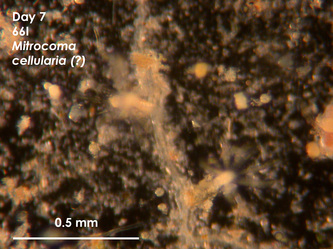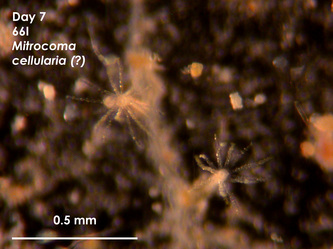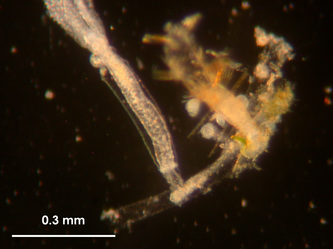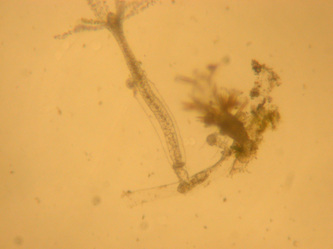Mitrocoma cellularia (?)
The hydroid depicted in the following photographs is, to the best of our knowledge, Mitrocoma cellularia.* The hydroid grew stolons across the surface of the substrate and produced hydranths (polyps) that grew upright, perpendicular to the substrate. The hydranths were surrounded by a hydrotheca (a glassy encasing). The hydranth could withdraw completely into the hydrotheca. Each hydranth appeared to have a single whorl of 10-14 tentacles. Each tentacle had clusters of nematocysts at intervals, giving the tentacle a rough and uneven appearance. The operculum (cover or mouth of the hydrotheca) was composed of several thin ridges. At the base of the hydrotheca, there appeared to be a pedicel (stalk) which connected the hydrotheca to the stolon. This pedicel had a ridged or ringed appearance.
In order to identify the organism, photos were taken both from above (oral) and from a side view (lateral) of the organism. In order to provide a lateral view of the hydroid, the stolon was cut and the hydranth was pried away from the substrate. The hydranth floated parallel to the substrate while photos were taken.
In order to identify the organism, photos were taken both from above (oral) and from a side view (lateral) of the organism. In order to provide a lateral view of the hydroid, the stolon was cut and the hydranth was pried away from the substrate. The hydranth floated parallel to the substrate while photos were taken.
* This hydroid was identified using the Light and Smith Manual (2007) and an article by Widmer (2004). The one large discrepancy is that Mitrocoma cellularia as described in Widmer (2004) does not have an annulated pedicel, whereas the organism found in this project does.
Anatomy of Mitrocoma cellularia
Hydranth- a feeding polyp which branches off from the main stem and has a mouth and tentacles
Tentacles- feeding extensions from the hydranth which may be covered with stinging cells to capture prey
Hydrotheca- a glassy encasing into which the tentacles of the hydranth can retract
Pedicel- a narrower, stalk-like area which attaches the hydranth to the hydrorhiza
Hydrorhiza- the structure which attaches the hydroid to the substrate
Hypostome- the area around the mouth of the hydranth, in the middle of the tentacles
Operculum- ridges or triangular plates at the open end of the hydrotheca
Tentacles- feeding extensions from the hydranth which may be covered with stinging cells to capture prey
Hydrotheca- a glassy encasing into which the tentacles of the hydranth can retract
Pedicel- a narrower, stalk-like area which attaches the hydranth to the hydrorhiza
Hydrorhiza- the structure which attaches the hydroid to the substrate
Hypostome- the area around the mouth of the hydranth, in the middle of the tentacles
Operculum- ridges or triangular plates at the open end of the hydrotheca








